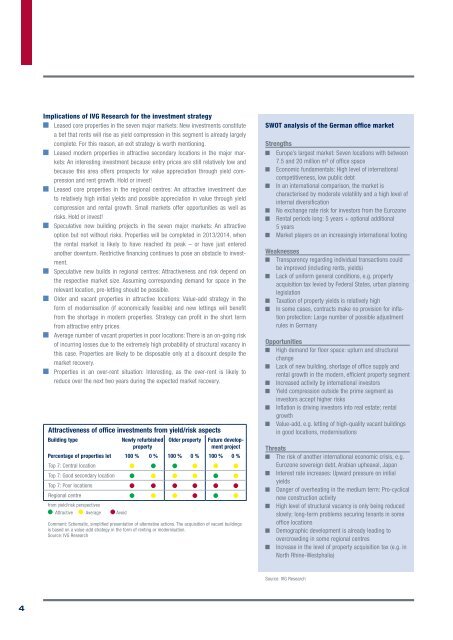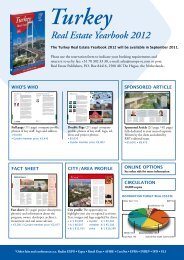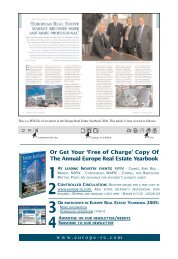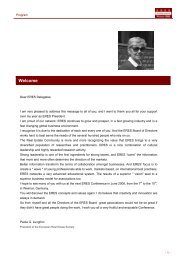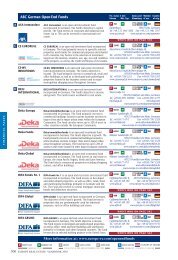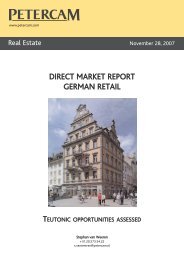Market Report 2011 GerMany - Europe Real Estate
Market Report 2011 GerMany - Europe Real Estate
Market Report 2011 GerMany - Europe Real Estate
You also want an ePaper? Increase the reach of your titles
YUMPU automatically turns print PDFs into web optimized ePapers that Google loves.
4<br />
Implications of IVG Research for the investment strategy<br />
Leased core properties in the seven major markets: New investments constitute<br />
a bet that rents will rise as yield compression in this segment is already largely<br />
complete. For this reason, an exit strategy is worth mentioning.<br />
Leased modern properties in attractive secondary locations in the major markets:<br />
An interesting investment because entry prices are still relatively low and<br />
because this area offers prospects for value appreciation through yield compression<br />
and rent growth. Hold or invest!<br />
Leased core properties in the regional centres: An attractive investment due<br />
to relatively high initial yields and possible appreciation in value through yield<br />
compression and rental growth. Small markets offer opportunities as well as<br />
risks. Hold or invest!<br />
Speculative new building projects in the seven major markets: An attractive<br />
option but not without risks. Properties will be completed in 2013/2014, when<br />
the rental market is likely to have reached its peak – or have just entered<br />
another downturn. Restrictive financing continues to pose an obstacle to investment.<br />
Speculative new builds in regional centres: Attractiveness and risk depend on<br />
the respective market size. Assuming corresponding demand for space in the<br />
relevant location, pre-letting should be possible.<br />
Older and vacant properties in attractive locations: Value-add strategy in the<br />
form of modernisation (if economically feasible) and new lettings will benefit<br />
from the shortage in modern properties. Strategy can profit in the short term<br />
from attractive entry prices.<br />
Average number of vacant properties in poor locations: There is an on-going risk<br />
of incurring losses due to the extremely high probability of structural vacancy in<br />
this case. Properties are likely to be disposable only at a discount despite the<br />
market recovery.<br />
Properties in an over-rent situation: Interesting, as the over-rent is likely to<br />
reduce over the next two years during the expected market recovery.<br />
Attractiveness of office investments from yield/risk aspects<br />
Building type Newly refurbished<br />
property<br />
Older property Future development<br />
project<br />
Percentage of properties let 100 % 0 % 100 % 0 % 100 % 0 %<br />
Top 7: Central location<br />
Top 7: Good secondary location<br />
Top 7: Poor locations<br />
Regional centre<br />
from yield/risk perspectives<br />
Attractive Average Avoid<br />
Comment: Schematic, simplified presentation of alternative actions. The acquisition of vacant buildings<br />
is based on a value-add strategy in the form of renting or modernisation.<br />
Source: IVG Research<br />
SWOT analysis of the German office market<br />
Strengths<br />
<strong>Europe</strong>’s largest market: Seven locations with between<br />
7.5 and 20 million m² of office space<br />
Economic fundamentals: High level of international<br />
competitiveness, low public debt<br />
In an international comparison, the market is<br />
characterised by moderate volatility and a high level of<br />
internal diversification<br />
No exchange rate risk for investors from the Eurozone<br />
Rental periods long: 5 years + optional additional<br />
5 years<br />
<strong>Market</strong> players on an increasingly international footing<br />
Weaknesses<br />
Transparency regarding individual transactions could<br />
be improved (including rents, yields)<br />
Lack of uniform general conditions, e.g. property<br />
acquisition tax levied by Federal States, urban planning<br />
legislation<br />
Taxation of property yields is relatively high<br />
In some cases, contracts make no provision for inflation<br />
protection: Large number of possible adjustment<br />
rules in Germany<br />
Opportunities<br />
High demand for floor space: upturn and structural<br />
change<br />
Lack of new building, shortage of office supply and<br />
rental growth in the modern, efficient property segment<br />
Increased activity by international investors<br />
Yield compression outside the prime segment as<br />
investors accept higher risks<br />
Inflation is driving investors into real estate; rental<br />
growth<br />
Value-add, e.g. letting of high-quality vacant buildings<br />
in good locations, modernisations<br />
Threats<br />
The risk of another international economic crisis, e.g.<br />
Eurozone sovereign debt, Arabian upheaval, Japan<br />
Interest rate increases: Upward pressure on initial<br />
yields<br />
Danger of overheating in the medium term: Pro-cyclical<br />
new construction activity<br />
High level of structural vacancy is only being reduced<br />
slowly; long-term problems securing tenants in some<br />
office locations<br />
Demographic development is already leading to<br />
overcrowding in some regional centres<br />
Increase in the level of property acquisition tax (e.g. in<br />
North Rhine-Westphalia)<br />
Source: IVG Research


